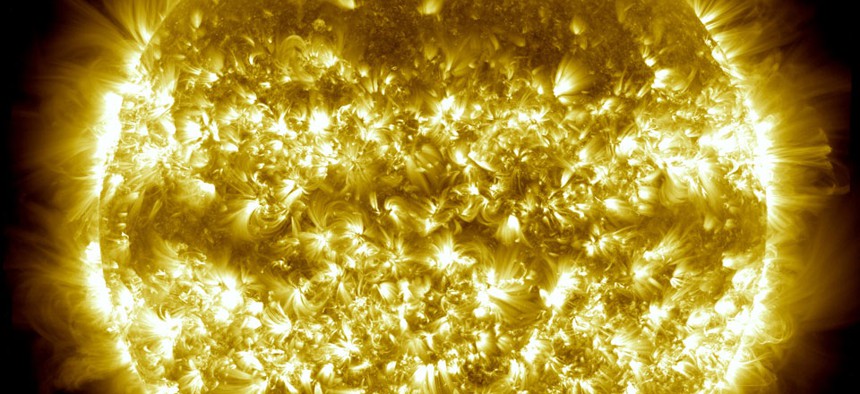Space Storms Could Knock Out the World’s Entire Critical Communications Infrastructure

A composite of 25 images of the sun recorded in extreme ultraviolet light by the orbiting Solar Dynamics Observatory between April 16, 2012 and April 15, 2013. NASA
There's a reason why the US government keeps such a close eye on the sun.
In 1859, from Aug. 28 to Sept. 2, we were given an important lesson about how vulnerable we are to the Sun’s power. The Carrington Event, named for the amateur astronomer who recorded it, Richard Christopher Carrington, was a coronal mass ejection: a huge burst of solar wind. When this solar storm hit the Earth’s magnetic field it caused an aurora so bright it could be seen as far south as the Caribbean and Hawaii. But the novelty of being able to read a newspaper by this eerie light was not the only effect caused by the arrival of the storm.
One of the least reported impacts of the 1859 solar storm was the massive disruption it caused to the telegraph systems across Europe and North America. Telegraph operators were said to have been shocked by their equipment while telegraph poles threw off sparks. The amount of power delivered by the storm was so great that some telegraph operators were able to disconnect their power supplies (pdf) and still send messages.
Roll forward to today and consider how much more dependent we are on communications. In 1859, telegraphs were the height of innovation. Now practically every business in the country relies on electronic technology to some extent. Much of our working life is spent sending and receiving emails and our social lives exist increasingly online. We store important personal information on our computers and depend more and more on internet services to complete everyday tasks like our shopping and finances. So imagine if the internet started throwing off sparks of its own.
Thankfully, much of the internet uses fiber optic cables and would be protected from a solar storm on the scale of the Carrington Event. But local distribution is still done using old fashioned copper cabling. This is exactly the sort of network that is vulnerable to space weather. In March 1989 a solar storm hit the Quebec Hydro Electricity network, disrupting the entire region. The degree of disruption obviously depends on the intensity, duration and location of a solar storm hitting the Earth. But, should something such as the Carrington Event occur today it would have a serious impact on the Earth’s communication and power systems, which in turn would have an inevitable impact of the economic activities of those affected.
NEXT STORY: TSP Board Switches Tech Contractors





